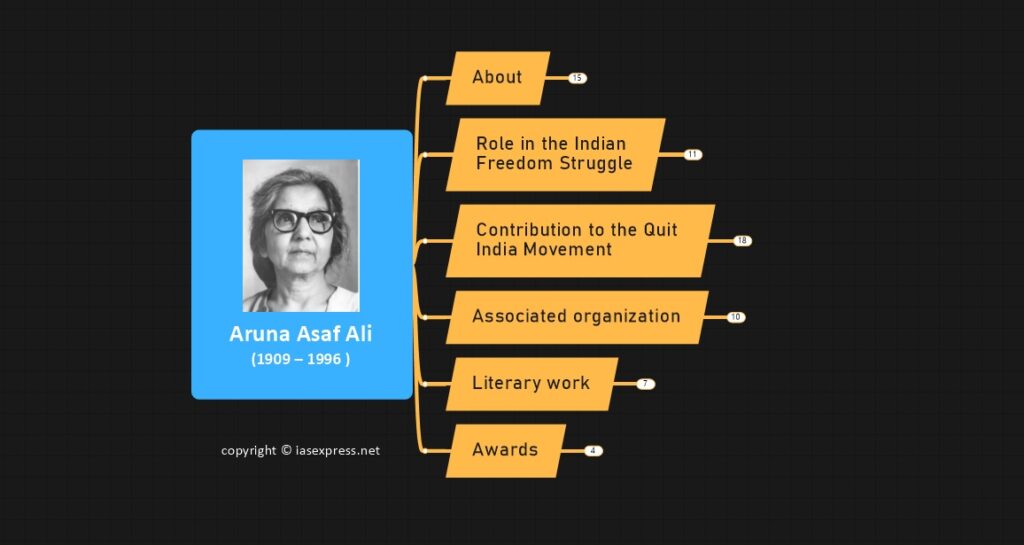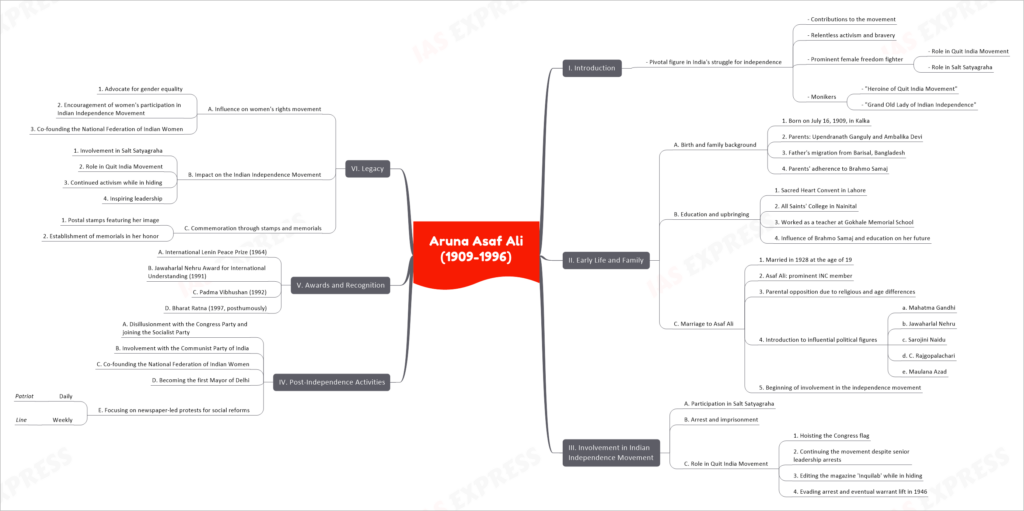Aruna Asaf Ali (1909-1996): Biography, Contributions, Legacy

I. Introduction
Aruna Asaf Ali, born Aruna Ganguly, was a pivotal figure in India’s struggle for independence, making significant contributions to the movement through her relentless activism and bravery. As a prominent female freedom fighter, she played a crucial role in the Quit India Movement and the Salt Satyagraha, earning her the moniker “Heroine of Quit India Movement” and the “Grand Old Lady of Indian Independence.” This essay will delve into Aruna Asaf Ali’s life, detailing her early years, involvement in the Indian Independence Movement, post-independence activities, and the various awards and recognition she received for her efforts. By examining her legacy, we will understand the impact she made on the women’s rights movement and India’s journey to independence.
II. Early Life and Family
Aruna Asaf Ali’s journey began with her upbringing in a liberal and religious Bengali family, which laid the foundation for her eventual contributions to India’s independence movement.
A. Birth and family background
Born on July 16, 1909, in Kalka, Aruna Ganguly was the daughter of Upendranath Ganguly and Ambalika Devi. Her father was a restaurant owner who had migrated from Barisal, Bangladesh, to the United Provinces (present-day Uttar Pradesh). Both her parents were devout adherents of the Brahmo Samaj, a monotheistic reformist movement that originated during the Bengal Renaissance.
B. Education and upbringing
Aruna received a well-rounded education, attending the Sacred Heart Convent in Lahore before pursuing higher education at All Saints’ College in Nainital. Following her graduation, she worked as a teacher at Calcutta’s Gokhale Memorial School. Her exposure to the liberal ideals of the Brahmo Samaj and her education played a significant role in shaping her future involvement in the Indian independence movement.
C. Marriage to Asaf Ali
In 1928, 19-year-old Aruna married Asaf Ali, a prominent member of the Indian National Congress (INC), in Allahabad. Despite facing opposition from her parents due to religious and age differences, Aruna’s marriage to Asaf Ali introduced her to influential political figures of the time, including Mahatma Gandhi, Jawaharlal Nehru, Sarojini Naidu, C. Rajgopalachari, and Maulana Azad, who all attended their wedding. This union marked the beginning of Aruna Asaf Ali’s active involvement in the struggle for India’s independence.
III. Involvement in Indian Independence Movement
A. Participation in Salt Satyagraha
Aruna Asaf Ali actively participated in the Salt Satyagraha, a key nonviolent agitation during the struggle for Indian independence. This act demonstrated her commitment to the cause and the principles of the Indian National Congress (INC).
B. Arrest and imprisonment
As a result of her involvement in the Salt Satyagraha, Aruna was arrested and imprisoned by the colonial authorities. However, she was not released under the Gandhi-Irwin Pact, which had promised the release of those detained during the Salt Satyagraha. Only after strong protests by Mahatma Gandhi and other female freedom fighters was Aruna eventually released.
C. Role in Quit India Movement
- Hoisting the Congress flag: On August 8, 1942, the Indian National Congress passed the Quit India resolution. Despite the arrest of many key leaders, Aruna Asaf Ali led the remaining party members to Gowalia Tank Maidan and boldly unfurled the Congress flag, signaling the launch of the Quit India Movement.
- Continuing the movement despite senior leadership arrests: Even with the absence of senior leadership, Aruna’s courage and determination fueled the ongoing protests and demonstrations throughout the region, proving the unstoppable force of nationalism.
- Editing the magazine ‘Inquilab’ while in hiding: While evading arrest, Aruna took on the role of editor for ‘Inquilab’, a publication of the Congress party. This allowed her to continue inspiring the youth to fight for freedom through constructive revolution rather than passive activism.
- Evading arrest and eventual warrant lift in 1946: The British government offered a reward of Rs. 5000 for her capture, but Aruna managed to remain hidden. Despite Mahatma Gandhi’s pleas to surrender, she did not emerge until 1946, when the arrest warrant in her name was finally lifted.
IV. Post-Independence Activities
A. Disillusionment with the Congress Party and joining the Socialist Party
After India gained independence, Aruna Asaf Ali became disillusioned with the Indian National Congress. As a result, she decided to join the Socialist Party in pursuit of her political and social objectives.
B. Involvement with the Communist Party of India
Aruna’s quest for social justice also led her to associate with the Communist Party of India. Although she never formally joined the party, she supported and collaborated with it on various occasions.
C. Co-founding the National Federation of Indian Women
A staunch advocate for women’s rights, Aruna Asaf Ali played a pivotal role in co-founding the National Federation of Indian Women. This organization aimed to promote gender equality and empower women across the nation.
D. Becoming the first Mayor of Delhi
In 1958, Aruna Asaf Ali achieved a significant milestone in her political career by becoming the first Mayor of Delhi. During her tenure, she implemented important civic reforms and worked tirelessly for the betterment of the city.
E. Focusing on newspaper-led protests for social reforms
However, Aruna eventually grew tired of the political infighting and resigned from her position as Mayor. Instead, she shifted her focus to newspaper-led protests to rally support for social reforms, further contributing to the betterment of society. She started a weekly journal ‘Link‘ and newspaper ‘Patriot‘ to attain this objective.
V. Awards and Recognition
Aruna Asaf Ali’s unwavering commitment to social reform and her significant contributions to India’s independence struggle garnered her various prestigious awards and recognition throughout her life.
A. In 1964, she was awarded the International Lenin Peace Prize, which recognizes her efforts in promoting peace and understanding.
B. Her commitment to fostering international understanding was further acknowledged in 1991 when she received the Jawaharlal Nehru Award for International Understanding.
C. Recognizing her exceptional service to the nation, the Indian government honored her with the Padma Vibhushan in 1992, the second-highest civilian award in India.
D. Finally, in 1997, a year after her death, Aruna Asaf Ali was posthumously awarded the highest civilian honor, the Bharat Ratna, in recognition of her lifelong dedication to India’s freedom struggle and her numerous contributions to Indian society.
VI. Legacy
Aruna Asaf Ali’s contributions to Indian history have left a significant legacy that continues to inspire generations.
A. Influence on women’s rights movement
Aruna played a pivotal role in the struggle for women’s rights in India. As a strong advocate for gender equality, she encouraged women to actively participate in the Indian Independence Movement and co-founded the National Federation of Indian Women. Her work in this area has had a lasting impact on the women’s rights movement in the country.
B. Impact on the Indian Independence Movement
Aruna’s unwavering dedication to India’s freedom struggle was instrumental in shaping the course of the movement. Her involvement in the Salt Satyagraha, Quit India Movement, and continued activism even while in hiding demonstrated her resolute commitment to the cause. Her actions and fearless leadership inspired others to join the fight for India’s independence.
C. Commemoration through stamps and memorials
In recognition of her contributions to the nation, the Indian government has honored Aruna Asaf Ali with various forms of commemoration. This includes the release of postal stamps featuring her image and the establishment of memorials in her honor. These tributes serve as a reminder of her unwavering spirit and dedication to the cause of freedom and equality.
VII. Conclusion
In conclusion, Aruna Asaf Ali’s life and work left a lasting impact on the Indian Independence Movement and women’s rights in India. As an active participant in various nationalistic campaigns and a dedicated advocate for gender equality, she significantly contributed to the nation’s struggle for freedom. Her unwavering dedication and commitment to social reforms continued even after India’s independence. Aruna Asaf Ali remains an inspiration for generations to come, and her influence and legacy live on through the numerous awards, recognitions, and memorials that celebrate her invaluable contributions to India’s history.


